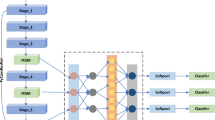Abstract
To solve the problem of low recognition accuracy and long recognition time in conventional methods for digital moving image feature recognition, a method for digital image feature recognition on mobile platforms based on machine learning is proposed. The support vector machine method is used to cluster the dataset, and then the weight reconstruction method is used to reduce the dimension of digital moving image data. The reduced dimension of the digital moving image is embedded in the coordinates to obtain the reduced dimension of the image data information and complete the feature recognition of the digital moving image. The simulation results show that the recognition accuracy of this method in recognizing features of moving digital images is basically stable at more than 95% and the running time is 0.42s. The recognition effect of the proposed method is good, the recognition efficiency is high, and it has some practical application value.






Similar content being viewed by others
Data availability
We also declare that data availability and ethics approval is not applicable in this paper.
References
Lee MJ, Ximenes AR, Padmanabhan P et al (2018) High-performance back-illuminated three-dimensional stacked Single-Photon Avalanche Diode implemented in 45-nm CMOS Technology[J]. IEEE J Sel Top Quantum Electron PP(99):1–1
Yellamraju T, Boutin MireiLLE (2018) Clusterability and clustering of images and other “Real” high-dimensional Data[J]. IEEE Trans Image Process 27(4):1927–1938
Xing HZ, Zhang QB, Ruan D et al (2018) Full-field measurement and fracture characterisations of rocks under dynamic loads using high-speed three-dimensional digital image correlation[J]. Int J Impact Eng 113(MAR):61–72
Tien ND, Danh PT, Rae BN et al (2018) Combining deep and handcrafted image features for presentation attack detection in face recognition systems using visible-light camera sensors[J]. Sensors 18(3):699–712
Savchenko AV (2019) Sequential three-way decisions in multi-category image recognition with deep features based on distance factor[J]. Inf Sci 489(23):18–36
Lijian Z, Chen Z, Zuowei W et al (2018) Hierarchical palmprint feature extraction and recognition based on multi-wavelets and complex network[J]. IET Image Proc 12(6):985–992
Shuai L, Shuai W, Xinyu L et al (2022) Human Inertial thinking strategy: a novel fuzzy reasoning mechanism for IoT-assisted visual monitoring[J]. IEEE Internet Things J, online first. https://doi.org/10.1109/JIOT.2022.3142115
Ukita J (2020) Causal importance of low-level feature selectivity for generalization in image recognition[J]. Neural Netw 125:185–193
Shuai L, Shuai W, Xinyu L et al (2021) Fuzzy detection aided real-time and robust visual tracking under complex environments. IEEE Trans Fuzzy Syst 29(1):90–102
Jiang S, Min W, Liu L et al (2020) Multi-scale multi-view deep feature aggregation for food recognition[J]. IEEE Trans Image Process 29(1):265–276
Liu S, Wang S, Liu X et al (2021) Human memory update strategy: a multi-layer template update mechanism for remote visual monitoring. IEEE Trans Multimedia 23:2188–2198
Zyurt F (2019) Efficient deep feature selection for remote sensing image recognition with fused deep learning architectures[J]. J Supercomput 16(4):1–19
Liu S, Liu X, Wang S et al (2021) Fuzzy-aided solution for out-of-view challenge in visual tracking under IoT assisted complex environment. Neural Comput Appl 33(4):1055–1065
Sakaino H (2019) Spatio-temporal feature extraction/recognition in videos based on energy optimization[J]. IEEE Trans Image Process 28(7):3395–3407
Liu S, Guo S, Fadi A et al (2020) Reliability of response region: a novel mechanism in visual tracking by edge computing for IIoT environments. Mech Syst Signal Process 138:106537
Fu Y (2020) Texture feature extraction and recognition of underwater target image considering incomplete tree wavelet decomposition[J]. J Coastal Res 107(sp1):25–33
Lee YK, Song J, Won Y (2019) Improving personal information detection using OCR feature recognition rate[J]. J Supercomput 75(4):1941–1952
Sharma P, Anand RS (2020) Depth data and fusion of feature descriptors for static gesture recognition[J]. IET Image Proc 14(5):121–137
Oh SH, Kim GW, Lim KS (2018) Compact deep learned feature-based face recognition for visual internet of Things[J]. J supercomput 74(12):6729–6741
Tehmina K, Muhammad AS, Muhammad M et al (2018) Emotion recognition from facial expressions using hybrid feature descriptors[J]. IET Image Proc 12(6):1004–1012
Author information
Authors and Affiliations
Contributions
Minqing Yang provided the algorithm and experimental results, wrote the manuscript, Jerry Chun-Wei Lin revised the paper, supervised and analyzed the experiment.
Corresponding author
Ethics declarations
The authors have no relevant financial or non-financial interests to disclose.
Additional information
Publisher’s note
Springer Nature remains neutral with regard to jurisdictional claims in published maps and institutional affiliations.
Rights and permissions
Springer Nature or its licensor (e.g. a society or other partner) holds exclusive rights to this article under a publishing agreement with the author(s) or other rightsholder(s); author self-archiving of the accepted manuscript version of this article is solely governed by the terms of such publishing agreement and applicable law.
About this article
Cite this article
Yang, MQ., Lin, J.CW. Digital Image Feature Recognition Method of Mobile Platform Based on Machine Learning. Mobile Netw Appl 27, 2506–2514 (2022). https://doi.org/10.1007/s11036-022-02069-4
Accepted:
Published:
Issue Date:
DOI: https://doi.org/10.1007/s11036-022-02069-4




